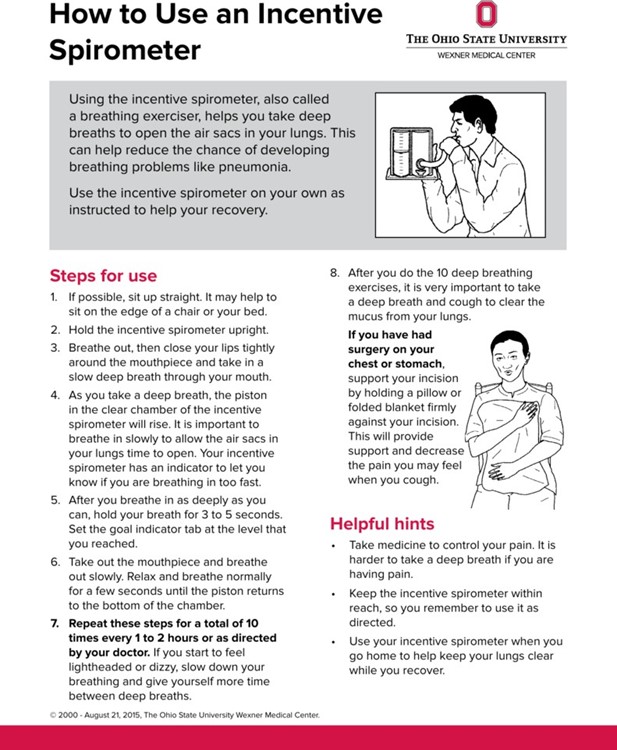A client is using an incentive spirometer on the first postoperative day after an inguinal herniorrhaphy. The practical nurse (PN) should reteach the proper use of the spirometer when the client demonstrates which action.
Blowing forcefully into the mouthpiece.
Exhaling slowly after two seconds.
Using a tight seal around the mouthpiece.
Sitting upright during the treatment.
The Correct Answer is A
The practical nurse (PN) should reteach the proper use of the spirometer when the client demonstrates blowing forcefully into the mouthpiece. The proper way to use an incentive spirometer is to sit upright, hold the spirometer upright, place your mouth around the mouthpiece, breathe out slowly, and then inhale slowly only through your mouth as deeply as you can. Blowing forcefully into the mouthpiece is not the correct way to use an incentive spirometer.
B. Exhaling slowly after two seconds: This is actually a correct action when using an incentive spirometer. The proper way to use an incentive spirometer is to exhale slowly before inhaling deeply.
C. Using a tight seal around the mouthpiece: This is also a correct action when using an incentive spirometer. It’s important to create a tight seal around the mouthpiece with your lips to ensure that you’re inhaling and exhaling only through your mouth.
D. Sitting upright during the treatment: This is another correct action when using an incentive spirometer. Sitting upright helps you to breathe more deeply and fully, which is the goal of using an incentive spirometer.

Nursing Test Bank
Naxlex Comprehensive Predictor Exams
Related Questions
Correct Answer is ["B","E"]
Explanation
The PN should instruct the UAP to observe and report any ear drainage after removing the device, as this may indicate an infection or irritation of the ear canal. The PN should also instruct the UAP to verify that the device is labeled with client's identification, as this can prevent mix-ups or misplacement of the device. The PN should also instruct the UAP to remove ear wax from the device's surface, as this can improve the sound quality and prevent damage to the device.
The other options are not correct because:
a. Keeping the battery door closed during storage is not a correct instruction, as it can drain the battery and shorten its life span. The PN should instruct the UAP to keep the battery door open during storage, as this can conserve the battery power and prevent corrosion.
c. Storing the device on the window sill to prevent loss is not a correct instruction, as it can expose the device to heat, moisture, or sunlight, which can damage its components or affect its function. The PN should instruct the UAP to store the device in a dry, cool, and safe place, such as a case or a drawer.
Correct Answer is C
Explanation
- Medication administration is a process that involves prescribing, dispensing, and giving medications to patients. It is a critical and complex task that requires accuracy, safety, and adherence to the rights of medication administration, such as the right patient, right drug, right dose, right route, right time, right documentation, and right response.
- When a male client tells the practical nurse (PN) that the pill he has been taking at home is a different color and size than the one the PN is trying to give him now, this may indicate a potential medication error
or discrepancy. A medication error is any preventable event that may cause or lead to inappropriate medication use or patient harm. A medication discrepancy is any difference between the current and previous medication regimens of a patient.
- The PN should respond to the client's concern by telling him that the PN will verify that the dispensed medication is a valid prescription. This means that the PN will check the medication label, the medication order, and the medication administration record (MAR) to confirm that the medication given to the client matches the one prescribed by the healthcare provider. The PN will also compare the dispensed medication with a drug reference guide or a picture of the medication to ensure that it is the correct drug and dosage form. The PN will also report any suspected errors or discrepancies to the healthcare provider or the pharmacy for clarification or correction.
- Options A, B, and D are incorrect answers, as they do not reflect the appropriate or responsible actions for the PN to take when faced with a possible medication error or discrepancy.
Whether you are a student looking to ace your exams or a practicing nurse seeking to enhance your expertise , our nursing education contents will empower you with the confidence and competence to make a difference in the lives of patients and become a respected leader in the healthcare field.
Visit Naxlex, invest in your future and unlock endless possibilities with our unparalleled nursing education contents today
Report Wrong Answer on the Current Question
Do you disagree with the answer? If yes, what is your expected answer? Explain.
Kindly be descriptive with the issue you are facing.
